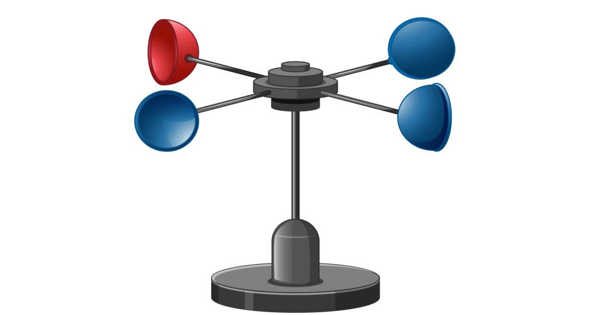An anemometer is a device that measures wind speed and pressure. It is a device for determining wind speed and direction. It is also a common instrument in weather stations. The term comes from the Greek word anemos, which means wind, and it refers to any wind speed instrument used in meteorology.
Meteorologists, who study weather patterns, rely heavily on anemometers. Leon Battista Alberti provided the first known description of an anemometer in 1450. Three or four cups are attached to horizontal arms in the most common type of anemometer. A vertical rod connects the arms. The cups rotate as the wind blows, causing the rod to spin. The faster the rod spins, the stronger the wind blows. The anemometer counts the number of rotations, or turns, and uses this information to calculate wind speed. Wind speed is usually averaged over a short period of time because it is not consistent—there are gusts and lulls.
An anemometer can measure the total velocity magnitude, the velocity magnitude on a horizontal plane, or the velocity component in a particular direction.
The anemometer has changed little since its development in the 15th century. Leon Battista Alberti (1404–1472) is said to have invented the first mechanical anemometer around 1450. In the following centuries, numerous others, including Robert Hooke (1635–1703), developed their own versions, with some being mistakenly credited as the inventor. In 1846, John Thomas Romney Robinson (1792–1882) improved upon the design by using four hemispherical cups and mechanical wheels. In 1926, Canadian meteorologist John Patterson (January 3, 1872 – February 22, 1956) developed a three-cup anemometer, which was improved by Brevoort and Joiner in 1935. In 1991, Derek Weston added the ability to measure wind direction. In 1994, Andreas Pflitsch developed the sonic anemometer.

Uses
Anemometers are used at almost all weather stations, from the arctic to the tropics. Wind speed can help pilots, engineers, and climatologists detect changes in weather patterns, such as an approaching storm.
Laser anemometers are frequently used by aerospace engineers and physicists. In velocity experiments, this type of anemometer is used. The rate and direction of change in an object’s position are measured by velocity. Laser anemometers, for example, calculate the wind speed around automobiles, airplanes, and spacecraft. Engineers use anemometers to make these vehicles more aerodynamic.
The cup anemometer (found in weather stations) measures velocity in a plane perpendicular to the rotation cups’ axis. When the cup anemometer is mounted with the shaft perpendicular to the horizontal, it will only measure the wind component parallel to the ground. Other types of anemometers, such as vane anemometers, have their tips aligned with the total velocity vector. Before using an anemometer, determine how it should be positioned and what component of total velocity its measurement represents.
















